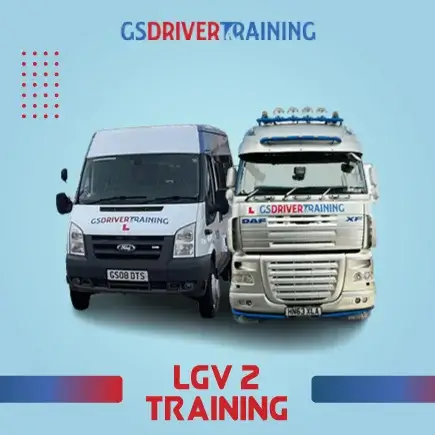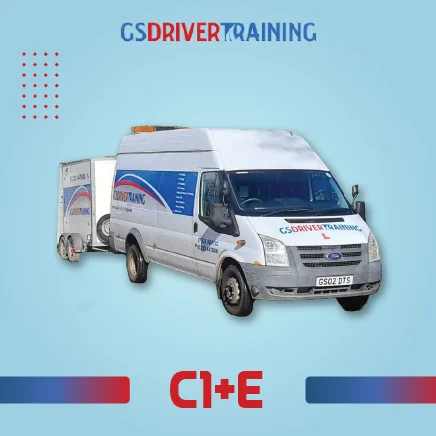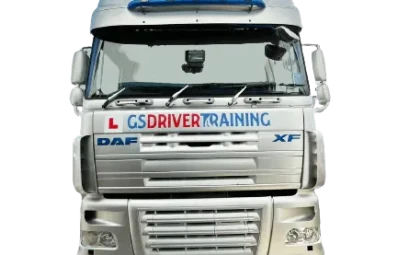
Ready to kickstart your career as an HGV driver in Surrey? Join GS Driver Training today and take the first step towards a successful journey on the road!
At GS Driver Training, we're committed to providing top-notch HGV driving training that equips you with the skills and knowledge needed for a safe and professional driving career. Our courses are designed to cover all four modules of the Driver Certificate of Professional Competence (CPC) and ensure that you are fully prepared to excel in your HGV driving career.
Why Choose GS Driver Training?
- Experienced and certified instructors.
- Comprehensive coverage of all CPC modules.
- Personalised support and guidance.
Don't wait, take the first step towards your HGV driving career with GS Driver Training. Contact us today to enrol in our courses and secure your future on the road.
Phone 01252 447808
Email Sales@gsdrivertraining.com
Whether you're starting from scratch or looking to enhance your HGV driving skills, GS Driver Training is your gateway to success. Join us now and drive your ambitions to new heights!
Overview of the benefits of HGV Training in Britain
HGV training in Britain is a great way to start a career in commercial driving. In the UK, many schools offer top-notch training, ensuring you get the best education. From in-depth practical drills to theoretical instruction, learning from the best HGV driving school in Britain is the perfect way to become a safe, professional driver. GS Driver Training offers the best HGV training in Surrey, helping you gain the necessary experience and skill set required for a successful driving career. Their courses are designed to teach you the fundamentals of HGV driving and the everyday nuances needed for a successful career.
Information about the different types of HGV Modules one to four
HGV training and licensing, the term "modules", refers to the different parts or components of the Driver Certificate of Professional Competence (CPC) qualification. The Driver CPC is a legal requirement for most professional drivers of large vehicles, including Heavy Goods Vehicles (HGVs). Here's an overview of the four modules of the Driver CPC:
Multiple-Choice Test: Module 1
In the multiple-choice test, you'll answer a series of questions presented on a computer screen. The questions cover a wide range of topics relevant to driving HGVs, including:
- Road signs and markings
- Rules of the road
- Vehicle handling
- Safety regulations
- Vehicle loading and weight distribution
- Health and Safety
- Environmental issues
You'll have a set amount of time to answer each question, and you'll need to select the correct answer from a list of options provided. You aim to demonstrate your understanding of road rules, safety practices, and your responsibilities as an HGV driver.
Hazard Perception Test: The hazard perception test evaluates your ability to identify potential hazards on the road and respond appropriately. This test assesses your anticipation and observation skills, which are crucial for safe driving. You'll watch a series of video clips that depict various driving scenarios. Some of these clips will contain developing hazards that require your attention.
Your task is to click the mouse when you spot a hazard that may require you to take action, such as changing speed or direction. The sooner you recognise the hazard, the higher your score will be for that clip. The hazard perception test assesses your ability to scan the road, identify potential risks, and respond promptly.
Both parts of Module 1 are designed to ensure that you have a strong understanding of road safety and can make informed decisions while driving an HGV. Passing Module 1 is a prerequisite for moving on to the following modules in your HGV training courses, which include practical demonstrations and driving tests.
Preparing thoroughly for Module 1 is essential to studying the relevant materials, practising with mock tests, and ensuring you understand the rules and concepts covered. Your success in Module 1 contributes to your overall competency as an HGV driver and your ability to ensure the safety of yourself and others on the road.
Module 1 consists of two parts: the multiple-choice test and the hazard perception test.
Case Studies Module 2
Module 2 of the HGV theory test, known as the Case Studies test, assesses your ability to apply your knowledge of road safety, regulations, and best practices to real-world scenarios that you might encounter as an HGV driver. This module tests your decision-making skills and how well you can apply your theoretical knowledge in practical situations. Here's an overview of what you can expect from CPC Module 2:
In this module, you'll be presented with case studies. Each case study is a real-life scenario that an HGV driver might encounter on the road. These scenarios cover a wide range of situations, such as:
- Road conditions
- Vehicle maintenance
- Route planning
- Safety considerations
- Loading and unloading
- Traffic management
You'll need to answer a series of questions for each case study. These questions will ask how you would respond to the situation presented in the scenario. Your responses should demonstrate your understanding of road safety rules, regulations, and best practices. You might be asked about actions you should take, decisions you should make, and factors you need to consider ensuring safe and responsible driving.
The Case Studies test is designed to assess how effectively you can apply your theoretical knowledge to practical situations. It's not just about knowing the rules; it's about understanding how those rules apply in real-life driving scenarios.
Preparation:
To prepare for Module 2:
- Review your knowledge of road safety, regulations, and other relevant topics covered in your HGV training.
- Practice working through case study scenarios and answering the best course of action questions.
- Familiarise yourself with the different aspects of HGV driving that may be covered in the case studies.
Module 2 is an essential part of your CPC qualification process. It ensures that you're knowledgeable about the theoretical aspects of HGV driving and capable of making informed decisions in dynamic situations. Passing Module 2 demonstrates your ability to handle real-world challenges and contributes to your overall competency as an HGV driver.
By completing Module 2, you'll be one step closer to obtaining your CPC qualification and becoming a safe and skilled HGV driver.
Module 3a Reverse Manoeuvre Test,
The HGV Module 3a reversing test, also known as the Reverse Manoeuvre Test, is a practical assessment conducted as part of the Driver Certificate of Professional Competence (CPC) qualification. This test evaluates your ability to perform controlled reversing manoeuvres with an HGV safely and accurately. Here's what you need to know about the HGV Module 3a reversing test:
Test Overview:
The reverse manoeuvre test assesses your skill in reversing an HGV accurately while maintaining control and avoiding obstacles.
Reverse into a Restricted Space: You'll be asked to reverse the HGV into a designated area, such as a parking bay or a narrow lane, without touching any markers or obstacles. During the test, the examiner will assess your ability to:
- Control the HGV accurately while reversing.
- Use mirrors and observations effectively to guide your manoeuvres.
- Avoid touching markers, cones, or obstacles.
- Position the HGV accurately within the designated area.
- Manoeuvre safely and confidently.
Coupling and Uncoupling:
This might involve reversing to a couple or uncoupling a trailer from the HGV accurately.
Preparation:
To prepare for the reversing test:
- Practice Reversing Maneuvers: Spend time practising the specific reversing exercises you'll be tested on. Familiarity and practice are crucial to success.
- Use Mirrors Effectively: Practice using mirrors and observing your surroundings while reversing.
- Control the Vehicle: Practice controlling the HGV's movements precisely during reversing.
- Understand Vehicle Dimensions: Be aware of the dimensions of the HGV and any trailers you'll be using for the test.
- Practice with an Instructor: Enlist the help of an experienced instructor to guide your practice sessions and provide feedback.
Test Success
Completing the reversing test demonstrates your ability to manoeuvre an HGV safely and accurately in various situations. It's an essential skill for HGV drivers, especially when navigating tight spaces, loading docks, or crowded areas.
The HGV Module 3a reversing test is designed to ensure that you can operate an HGV skilfully and safely, particularly when reversing is required. Practising the specific manoeuvres, honing your skills, and following the guidance of your instructor will increase your chances of passing this test and moving forward in your HGV training journey.
Practical Driving Test Module 3b
Practical Driving Test is the on-road driving test where you demonstrate your practical driving skills with an HGV on public roads. During this test, you'll need to drive an HGV under various road conditions while demonstrating your ability to handle the vehicle safely and responsibly.
Factors to consider when looking for an HGV driving school
When searching for a Heavy Goods Vehicle (HGV) driving school, several important factors should be considered to ensure you receive quality training and a positive learning experience. Here are the key factors to keep in mind:
Choose a school accredited and approved by relevant authorities, such as the Driver and Vehicle Standards Agency (DVSA) in the UK. Accreditation ensures that the training meets industry standards. Check online reviews, testimonials, and recommendations from past students. Positive feedback and a solid reputation indicate the school's quality of training. Consider the school's years of experience in providing HGV driving courses. Experienced schools often have well-developed training programs and knowledgeable instructors. Instructors should be qualified, experienced, and certified to teach HGV driving.
Their expertise plays a crucial role in your learning process. Visit the school's training facilities to assess their condition. Modern and well-maintained facilities contribute to practical training. Consider the school's training schedule and whether it fits your availability. Flexible training hours can accommodate various students' needs. While not the sole quality indicator, higher pass rates can reflect the school's effectiveness in preparing students for HGV tests. Ensure the school provides transparent pricing information without hidden fees. Remember that quality training has associated costs. A school that offers tailored training plans can address individual learning needs and preferences. Choose a school that is conveniently located, minimising travel time and expenses.
Reviews and Ratings of the Best HGV Driving Schools
However, you can find reviews and ratings of HGV driving schools by visiting online platforms such as Google Maps, Yelp, Trustpilot, and specialised driving school directories. These platforms allow users to leave reviews and rate their experiences with various driving schools. When looking for reviews and ratings, consider the following tips. Don't judge solely on one or two reviews. Read a variety of reviews to get a more comprehensive understanding of the driving school's strengths and weaknesses.
Look for common themes in the reviews. If multiple people mention the same positive or negative aspects, it's more likely to be accurate. Keep in mind that reviews can be subjective. Some people might have had exceptional experiences, while others might have had challenges that were specific to their situations.
Pay attention to the most recent reviews, as they reflect the current state of the driving school. A school's quality can change over time. Everyone has different learning preferences and needs. What might be an excellent fit for one person might be different for another. If you know anyone who recently completed HGV training courses, ask them for recommendations and insights about the schools they attended. Visit the schools you're interested in. This can give you a firsthand sense of the training environment and facilities.
Remember that while reviews and ratings can be helpful, they are just one part of your decision-making process. Your personal preferences, the school's location, training programs, and your specific goals should also factor into your decision.
Overview of the HGV Training Program, including the Theory and Practical Elements
- Theory Training: The theory component of the HGV courses program focuses on equipping aspiring drivers with the necessary knowledge and understanding of road safety, regulations, and best practices. It includes:
- Highway Code and Road Safety: Understanding the rules and regulations of driving on the road, including speed limits, traffic signs, and right-of-way rules.
- Vehicle Familiarisation: Learning about different types of HGVs, their components, and their functions.
- Legal Requirements: Understanding tachographs, drivers' hours regulations, and other legal aspects that HGV drivers need to adhere to.
- Route Planning: Learning to plan efficient routes, considering factors like road types, traffic, and time restrictions.
The practical training component of the HGV driver training program involves hands-on experience with driving an HGV under the guidance of qualified instructors. It includes:
- Vehicle Inspection: Learning how to perform thorough pre-trip and post-trip vehicle inspections to ensure safety and compliance.
- Basic Handling Skills: Practicing manoeuvres such as turning, reversing, and parking in various scenarios.
- On-Road Driving: Gaining experience in natural traffic conditions, including urban and rural environments, highways, and different weather conditions.
- Safety Procedures: Understanding emergency procedures, safe loading practices, and how to handle unexpected situations on the road.
- Coupling and Uncoupling: Learning to connect and disconnect trailers safely and efficiently.
- Manoeuvring Techniques: Mastering complex manoeuvres, such as reversing into tight spaces and navigating challenging terrain.
The Driver Certificate of Professional Competence (CPC)
In addition to the core HGV training, drivers may need to complete the Driver (Certificate of Professional Competence) CPC training. This is a legal requirement for most professional HGV drivers and involves ongoing training to maintain high standards of safety, efficiency, and professionalism. At the end of the training program, students will need to pass a practical driving test.
This test assesses their ability to safely operate an HGV, follow road rules, and handle various driving situations. Before taking the practical test, students are required to pass a theory test. This test assesses their knowledge of road rules, regulations, and safety practices. Many HGV training programs provide job placement assistance, helping graduates find employment opportunities in the transportation and logistics industry.
The Driver Certificate of Professional Competence (CPC) in the UK is a mandatory qualification for professional drivers of Heavy Goods Vehicles (HGVs) and Passenger Carrying Vehicles (PCVs). It consists of four modules, and one of these is the periodic training, commonly referred to as the "35 hours Driver CPC."
What Is the 35 Hours Driver CPC?
The 35 hours Driver CPC, often known as periodic training, is a requirement for all professional drivers to complete 35 hours of periodic training every five years to maintain their Driver CPC qualification. This training is designed to enhance a driver's knowledge, skills, and professionalism, ensuring they remain up-to-date with industry standards, safety regulations, and best practices.
Professional drivers must complete 35 hours of periodic training within a five-year cycle. This means undertaking this training every five years to keep their Driver CPC current. The periodic training covers a wide range of topics, including road safety, vehicle maintenance, eco-driving, and customer service. These topics are designed to improve a driver's competence and safety on the road. Periodic training must be completed at approved training centers.
These centers offer a variety of courses that fulfill the CPC requirements. Drivers have the flexibility to choose courses that align with their needs and interests, making the training relevant to their specific job roles. Drivers must keep records of their completed periodic training, and training centers also maintain records.
This is essential for compliance and maintaining the Driver CPC qualification. The 35 hours Driver CPC not only helps drivers meet legal requirements but also promotes continuous professional development. It enhances their knowledge and skills, making them safer and more efficient drivers.
Maintaining Your Driver CPC
To maintain your Driver CPC, be sure to complete the 35 hours of periodic training within the required time frame. You can choose courses that suit your career and interests, helping you become a better and more knowledgeable professional driver.
Remember to check with approved training centers for available courses and schedules. Compliance with the periodic training requirement is crucial for those in the HGV and PCV industries to continue their careers legally and professionally.
Continuous Professional Development:
If you already hold an HGV licence, but it's been a while since you've been on the road, consider enrolling in a refresher training program to ensure you can get back on the road safely and confidently. Here's what you can expect from such a program:
A refresher training program typically starts with an assessment of your current skills and knowledge. This helps the instructors identify areas that need improvement and tailor the training to your specific needs. Laws and regulations in the transportation industry can change over time. A refresher course will bring you up to date with the latest rules and regulations related to driving HGVs, ensuring you stay compliant. If there have been advancements in HGV technology since you last drove, the refresher course will familiarise you with any new features, controls, and safety systems in modern vehicles.
The refresher training will involve practising essential driving manoeuvres such as reversing, parking, and navigating tight spaces. This helps you regain confidence in handling the vehicle effectively. Refresh your defensive driving skills, which are crucial for anticipating and avoiding potential hazards on the road. The program will emphasise hazard perception and how to respond to unexpected situations, ensuring you're well-prepared for challenges that may arise while driving an HGV.
Review emergency procedures, including how to respond to breakdowns, accidents, and other unexpected events on the road. Brush up on road safety practices and risk management strategies to reduce the likelihood of accidents and ensure the safety of yourself and others.
The primary goal of the refresher training is to boost your confidence behind the wheel of an HGV. It's normal to feel a bit rusty after a break, and this training aims to restore your skills and comfort level. If there are specific areas where you feel less confident or require additional training, the refresher course can provide targeted practice to enhance those skills. The training will be tailored to your needs, focusing on areas that require the most attention. This personalised approach ensures that your training is effective and efficient. If you need to renew your Driver CPC, the refresher training can fulfil this requirement as well, ensuring you remain legally compliant.
By enrolling in a refresher training program, you can bridge the gap between your current skill level and the proficiency required to drive an HGV safely and confidently. This training is precious if you're planning to return to HGV driving after a period of inactivity or if you want to update your skills to match the latest industry standards.
Health and safety considerations when attending HGV training
Attending HGV (Heavy Goods Vehicle) training involves operating large and potentially hazardous vehicles on the road. As such, health and safety considerations are of paramount importance. Here's a list of health and safety considerations to keep in mind when attending HGV training:
Wear appropriate personal protective equipment, such as a high-visibility vest, safety boots, and any other gear recommended by the training provider. Ensure you're in good health and fit to drive an HGV. If you have any medical conditions that could affect your ability to drive, consult a healthcare professional and inform your training provider. Wear sturdy and comfortable footwear with a good grip to ensure proper control of the vehicle's pedals and safe movement around the training area. Wear comfortable and appropriate clothing that allows for easy movement and doesn't interfere with your ability to operate the vehicle. Always wear your seatbelt when seated in the HGV, whether you're driving or observing.
Seat belts are essential for your safety during training sessions. Before starting the training session, conduct a thorough inspection of the vehicle to ensure it's in proper working condition. Check brakes, lights, mirrors, tires, and other essential components. Listen carefully to the instructor's guidance and follow their instructions at all times.
They are experienced professionals who are focused on your safety and learning. Familiarise yourself with the controls of the HGV, including the steering wheel, pedals, gears, and any specialised equipment. Proper use of controls is crucial for safe operation. Adhere to all traffic rules and signals during practical training sessions. Follow speed limits, road signs, and signals to ensure the safety of yourself and others.
Be vigilant about identifying potential hazards on the road. Learn to anticipate and respond to potential risks, both during training and when you're driving in the future. Take into account weather conditions, road surfaces, and traffic when practising. Adjust your driving techniques accordingly. Stay in communication with the instructor and fellow trainees. Use clear and concise communication to ensure everyone is aware of your actions.
Avoid distractions such as using your phone or engaging in unrelated conversations during training. Stay focused on the task at hand. If training involves loading or unloading cargo, ensure it's done safely and in compliance with loading guidelines. Learn and practice emergency procedures, such as stopping the vehicle in case of mechanical issues or accidents. If the training involves extended periods of driving, take regular rest breaks to avoid fatigue.
If you have safety concerns about the vehicle, training area, or any aspect of the training, don't hesitate to communicate with your instructor or the training provider. Remember, the goal of HGV training is not only to learn to drive the vehicle but to do so safely and responsibly. By prioritising health and safety considerations, you'll create a secure learning environment for yourself and your fellow trainees.
Requirements for becoming a HGV driver
Becoming a Heavy Goods Vehicle (HGV) driver involves meeting specific requirements and completing a series of steps to obtain the necessary licences and qualifications. Here are the typical requirements for becoming an HGV driver:
In the UK, you must be at least 18 years old to drive an HGV and complete the CPC. You need a full car (Category B) UK driving licence before you can apply for an HGV licence. Undergo a medical examination by a registered medical practitioner to assess your physical and mental fitness to drive an HGV. The medical standards are more rigorous for HGV drivers due to the nature of the job.
Apply for a provisional Category C (rigid) or Category C+E (articulated) licence, depending on the type of HGV you intend to drive. You can apply for this through the Driver and Vehicle Licensing Agency (DVLA). Pass the relevant theory tests for the category of HGV licence you're applying for. This includes a multiple-choice test and a hazard perception test.
The questions cover road safety, regulations, and specific HGV-related knowledge. Undergo practical training at an approved training provider. The training includes both theoretical and practical aspects of driving an HGV. It covers vehicle controls, manoeuvres, road safety, and more. After completing your training, you'll need to pass a practical driving test.
The test assesses your ability to operate an HGV on public roads safely and includes vehicle checks, on-road driving, and manoeuvres. If you're planning to drive professionally, you'll need to complete the Driver CPC qualification. This involves passing a theory test and a practical demonstration test. The CPC is a legal requirement for most professional HGV drivers and involves ongoing training to maintain your professional competence.
If you're planning to drive specialised HGVs, such as those carrying hazardous materials, you may need additional qualifications, such as the ADR (Accord européen relatif au transport international des marchandises Dangereuses par Route) certification for transporting dangerous goods. After obtaining your HGV licence and any required certifications, you can begin seeking employment as an HGV driver. Employers may require some level of experience, so entry-level positions or trainee roles are a good starting point.
The employment opportunities available for those who have qualified as HGV drivers
Qualifying as a Heavy Goods Vehicle (HGV) driver opens up a range of employment opportunities in the transportation and logistics industry. Here are some of the employment opportunities available for qualified HGV drivers:
Long-haul trucking involves transporting goods over long distances, often across different cities or even countries. HGV drivers in this role may spend extended periods on the road, making deliveries to various destinations. Local delivery drivers transport goods within a specific region or city. This can include delivering to retail stores, warehouses, businesses, and even homes. These drivers typically have regular routes and may return home daily. Retail distribution drivers work for companies that distribute goods to retail stores. They ensure that goods are delivered on time and in good condition, helping maintain the supply chain for businesses.
HGV drivers are essential for moving bulk goods, raw materials, and finished products between manufacturers, warehouses, and distribution centres. Some HGV drivers work in the construction and industrial sectors, transporting heavy equipment, machinery, construction materials, and other items needed for projects. Tanker drivers transport liquids or gases, such as fuel, chemicals, or food products. This requires specialised training due to the unique handling requirements of tanker vehicles. Certain goods require specialised handling and transportation, such as refrigerated goods, hazardous materials, oversized loads, or livestock. HGV drivers with specialised qualifications are needed for these roles.
Moving companies often employ HGV drivers to transport household or office items during relocations. HGV drivers are needed to transport waste and recycling materials to disposal sites or recycling centres. Some qualified HGV drivers choose to work as independent contractors or owner-operators.
They may contract their services to various companies or operate their own transportation businesses. Qualified HGV drivers have the opportunity to work internationally, transporting goods across borders and even continents. International driving may require knowledge of customs regulations and different driving laws. Freight forwarding and logistics companies often employ HGV drivers to handle transportation aspects of their operations.
Haulage companies specialise in transporting goods using HGVs. They may offer a variety of transport services to different industries. With experience and additional qualifications, HGV drivers can advance to roles such as transport managers, dispatchers, and driver trainers or even start their own transportation businesses. It's important to note that the demand for qualified HGV drivers can vary based on factors such as geographic location, industry trends, and economic conditions. Overall, the transportation and logistics industry offers diverse employment opportunities for HGV drivers, making it a viable and potentially rewarding career choice.
Final thoughts on finding the best HGV driving school in Britain
Finding the best HGV driving school in Britain requires careful consideration and research. Here are some final thoughts to guide your search:
Look for schools that are accredited and approved by relevant authorities, such as the DVSA (Driver and Vehicle Standards Agency) in the UK. This ensures that the training meets industry standards. The expertise of instructors is crucial. Choose a school with experienced HGV instructors who can provide comprehensive training and guidance.
The best schools offer a comprehensive training program that covers both theory and practical aspects of HGV driving, including road safety, vehicle handling, and legal regulations. Ensure the school has a well-maintained and diverse fleet of HGVs for training purposes. Different types of vehicles can offer a more comprehensive training experience. While not the sole indicator of quality, higher pass rates can indicate the school's effectiveness in preparing students for HGV tests.
Check online reviews and testimonials from past students to get an idea of their experiences with the school. Positive feedback is a good sign. Some schools offer job placement assistance after training completion. This can be valuable for launching your HGV driving career. Inspect the training facilities.
They should be equipped with classrooms, practice areas, and vehicles that meet safety standards. Consider a school that offers flexible training schedules to accommodate your availability. The school should provide transparent pricing details without hidden fees. Be wary of unusually low prices, as quality training has its costs. Choose a school that is conveniently located, minimising travel time and expenses.
If you're interested in specialised transport (e.g., hazardous materials), check if the school offers relevant certifications. Visit the school in person to get a feel for the environment, talk to instructors, and see the training facilities. Ask for recommendations from friends, colleagues, or industry professionals who have undergone HGV training. A good school might offer tailored training plans to suit your learning pace and needs.
Remember that the "best" school may vary based on your individual preferences, learning style, and goals. Take your time to research and compare options before making a decision. Prioritise quality training that equips you with the skills and knowledge needed to become a safe and successful HGV driver in Britain.
FAQ
Q: What is the Best HGV Driving School in Britain?
A: The best HGV driving school in Britain is HGV Training Centres, based in Surrey. They provide a full range of HGV training courses and LGV training courses and have an impressive pass rate for their HGV drivers.
Q: What Makes HGV Training Centres the Best School in Surrey?
A: HGV Training Centres has a proven track record in the commercial driving industry, boasting an impressive pass rate for its HGV drivers. They also offer top-notch customer service, with experienced and knowledgeable instructors who can help you get your licence as quickly and as safely as possible.
Q: Are there any Private Options for HGV Training?
A: Yes, there are private options available for HGV training. HGV Training Centres offer a variety of private courses, both local and national, that are tailored to meet your needs.
Q: Are there any Common HGV Test Mistakes Made By Drivers?
A: Yes, there are some common mistakes that drivers often make when taking their HGV test. The most common are incorrect braking, reversing, and parking, as well as driving on the wrong side of the road and failing to look at the blind spot.
Q: What Can I Expect From a Typical HGV Training Course?
A: Typically, HGV training courses will cover a range of topics, from basic vehicle control to more advanced driving techniques. This includes laws and regulations, vehicle maintenance, defensive driving, and how to identify potential hazards on the road.
Q: Are HGV Training Courses Worth the Investment?
A: Yes, HGV training courses can be worth the investment. The courses will give you the skills necessary to be a safe and effective HGV driver, and they can be an invaluable addition to your CV. They can also open the door to new job opportunities.
Q: What Makes a Good HGV Training Company?
A: Good HGV training companies typically have experienced and knowledgeable instructors, offer quality training and customer service, and have an excellent pass rate for their drivers. It's also worth researching the company's reputation in the industry to make sure they are trustworthy and reliable.
Q: What are the Top 10 Common Mistakes to Avoid as an HGV Driver?
Q: How Can I Find a Good Training Centre Near Me?
A: The best way to find a good training centre near you is to do your research. Check online reviews, compare prices, and look at the company's track record and credentials. You may also want to contact the centre directly and ask any questions you may have.
Q: What are some of the benefits of attending a HGV Driving School?
A: Attending an HGV driving school provides the necessary qualifications and training to become an HGV or LGV driver. HGV and LGV drivers receive competitive salaries and job security, and they can work within a wide range of sectors. The courses also enable learners to become more employable and give them access to more job opportunities than if they were to become car drivers alone.
Q: How do I find the best HGV Driving School in Britain?
A: The best HGV driving schools in Britain are those that provide the best quality instruction and resources along with the highest pass rates. You can research schools online to compare their reputations and course offerings. If you are looking for a school in Surrey, London or elsewhere in the South East, consider GS Driver Training.
Q: Are there any top mistakes I should be aware of when attending a HGV Driving School?
A: It's important to ensure that you are adequately prepared for the course and any theory exams that may be required for it. Knowing the rules of the road prior to starting the course is essential, and thinking strategically about how to pass your HGV test is also a good idea. Focusing on your long-term goal, remaining patient throughout the training, and being respectful of instructors and other vehicles around you are also key.
Q: What should I expect when attending HGV Driving School?
A: You can expect the best service and guidance from your instructor. HGV driving courses are typically tailored to the requirements of the client, with the instructor aiming to ensure that each student gets the necessary knowledge and understanding to pass their HGV test with confidence. The instructor will discuss with the students what they need to do and what they should expect from the exclusive HGV training courses.
Q: What should I look out for when choosing a HGV Training Centre?
A: Look out for a reputable training centre with a good track record. The centre should be highly professional and have experienced instructors who are qualified and certified to teach the relevant courses. The prices should also be sensible, and the centre should be transparent and willing to answer any questions you have about their services.
Q: What is the HGV Test pass rate?
A: The HGV test pass rate can vary based on the individual's knowledge, skill, and experience. Generally, most pass rates are around 50%, but some schools may have higher or lower pass rates depending on their quality of teaching and level of support. Most HGV training schools should be able to provide the current pass rate and information on how to maximise your chances of passing.
Q: What is the best hgv school in Surrey?
A: When it comes to researching the best HGV training company in Surrey for potential drivers, there are a few key factors to focus on, such as the high pass rate they offer, the driving tuition they provide, and the benefits of the school. Surrey is a popular choice for HGV drivers due to its close proximity to London and the M25 motorway.
For anyone wanting to travel and work in this region. GS Driver Training is recognised as one of the best schools in the area and provides a wide range of services, from initial qualification and assessment procedures to training and assessment of on-road driving skills. Furthermore, one of the great benefits of their service is their offers on top HGV vehicles, allowing learners exclusive access to top-spec vehicles, cutting down on the need to hire them. Choosing the right HGV school can give candidates the best start in their new career, so it is essential to do your research and make the best choice.









